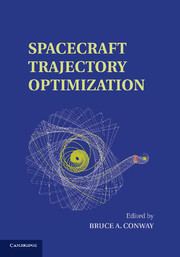Book contents
- Frontmatter
- Contents
- Preface
- 1 The Problem of Spacecraft Trajectory Optimization
- 2 Primer Vector Theory and Applications
- 3 Spacecraft Trajectory Optimization Using Direct Transcription and Nonlinear Programming
- 4 Elements of a Software System for Spacecraft Trajectory Optimization
- 5 Low-Thrust Trajectory Optimization Using Orbital Averaging and Control Parameterization
- 6 Analytic Representations of Optimal Low-Thrust Transfer in Circular Orbit
- 7 Global Optimization and Space Pruning for Spacecraft Trajectory Design
- 8 Incremental Techniques for Global Space Trajectory Design
- 9 Optimal Low-Thrust Trajectories Using Stable Manifolds
- 10 Swarming Theory Applied to Space Trajectory Optimization
- Index
- References
10 - Swarming Theory Applied to Space Trajectory Optimization
Published online by Cambridge University Press: 06 December 2010
- Frontmatter
- Contents
- Preface
- 1 The Problem of Spacecraft Trajectory Optimization
- 2 Primer Vector Theory and Applications
- 3 Spacecraft Trajectory Optimization Using Direct Transcription and Nonlinear Programming
- 4 Elements of a Software System for Spacecraft Trajectory Optimization
- 5 Low-Thrust Trajectory Optimization Using Orbital Averaging and Control Parameterization
- 6 Analytic Representations of Optimal Low-Thrust Transfer in Circular Orbit
- 7 Global Optimization and Space Pruning for Spacecraft Trajectory Design
- 8 Incremental Techniques for Global Space Trajectory Design
- 9 Optimal Low-Thrust Trajectories Using Stable Manifolds
- 10 Swarming Theory Applied to Space Trajectory Optimization
- Index
- References
Summary
Introduction
The determination of optimal (either minimum-time or minimum-propellant-consumption) space trajectories has been pursued for decades with different numerical optimization methods. In general, numerical optimization methods can be classified as deterministic or stochastic methods. Deterministic gradient-based methods assume the continuity and differentiability of the objective function to be minimized. In addition, gradient-based methods are local in nature and require the identification of a suitable first-attempt “solution” in the region of convergence, which is unknown a priori and strongly problem dependent. These circumstances have motivated the development of effective stochastic methods in the last decades. These algorithms are also referred to as evolutionary algorithms and are inspired by natural phenomena. Evolutionary computation techniques exploit a population of individuals, representing possible solutions to the problem of interest. The optimal solution is sought through cooperation and competition among individuals. The most popular class of these techniques is represented by the genetic algorithms (GA), which model the evolution of a species based on Darwin's principle of survival of the fittest. Differential evolution algorithms represent alternative stochastic approaches with some analogy with genetic algorithms, in the sense that new individuals are generated from old individuals and are eventually preserved after comparing them with their parents. Ant colony optimization is another method, inspired by the behavior of ants, whereas the simulated annealing algorithm mimics the equilibrium of large numbers of atoms during an annealing process.
Information
- Type
- Chapter
- Information
- Spacecraft Trajectory Optimization , pp. 263 - 294Publisher: Cambridge University PressPrint publication year: 2010
References
Accessibility standard: Unknown
Why this information is here
This section outlines the accessibility features of this content - including support for screen readers, full keyboard navigation and high-contrast display options. This may not be relevant for you.Accessibility Information
- 5
- Cited by
